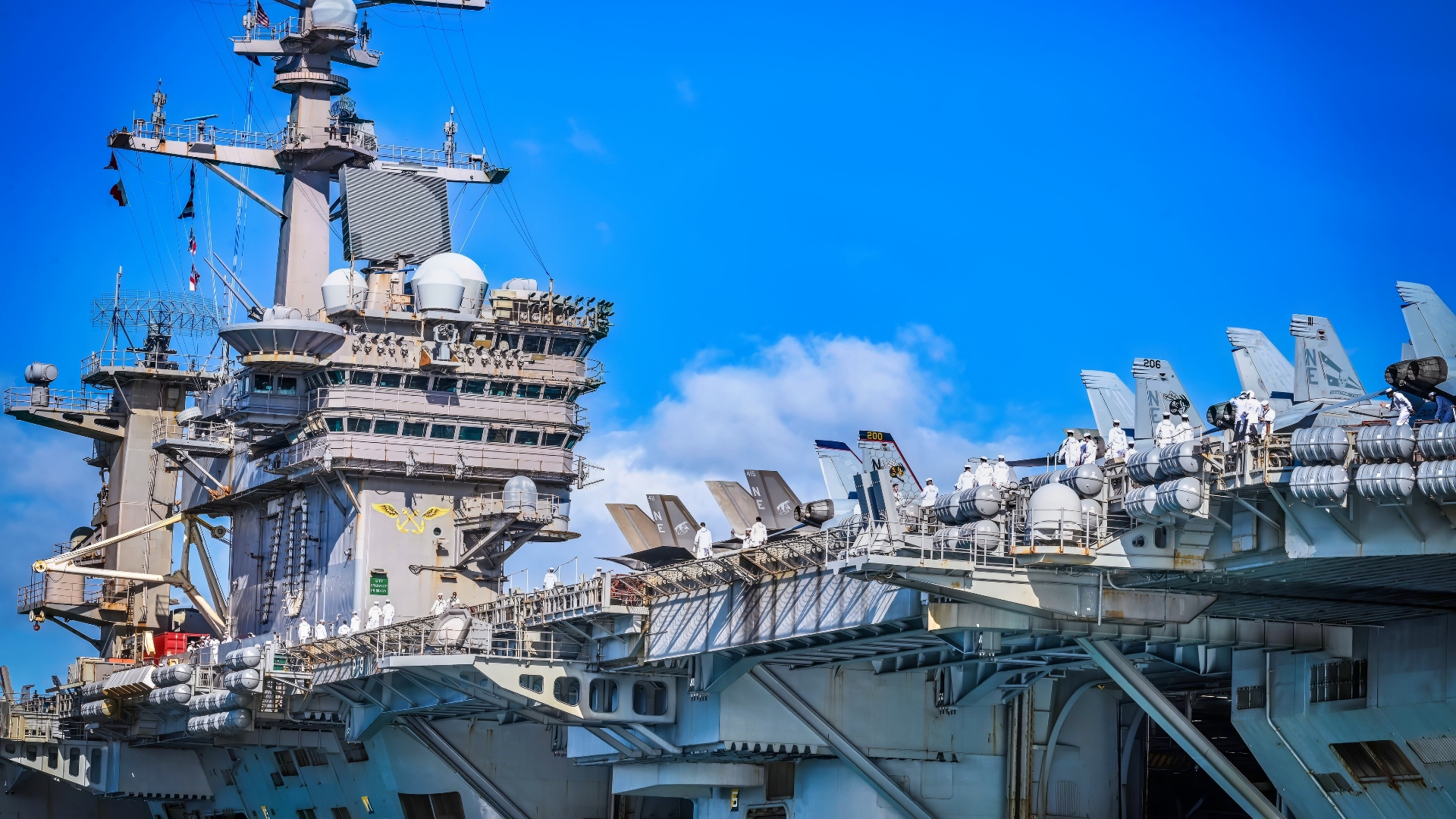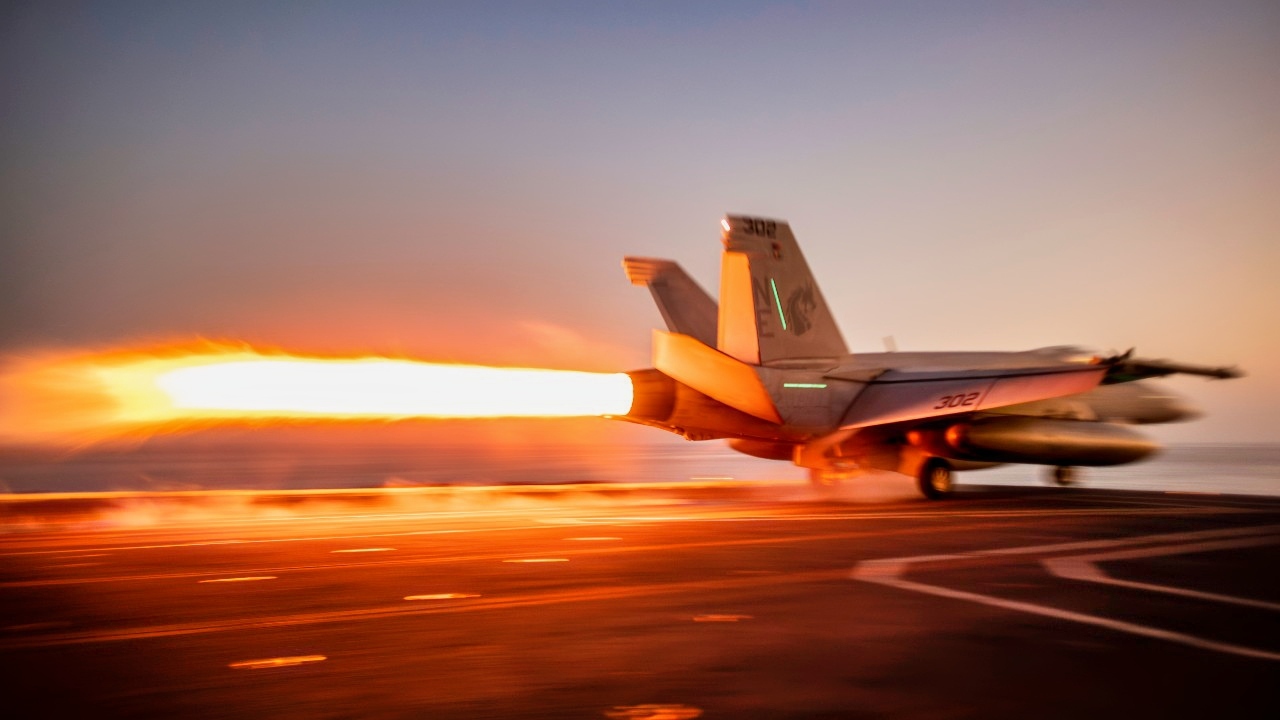Key Points and Summary – Why sell billion-dollar carriers for a penny? Because scrapping them costs a fortune.
-Decommissioned supercarriers like USS Kitty Hawk and USS John F. Kennedy are massive, hazardous, and expensive to tow, dismantle, and clean up. Their outdated tech has little resale value, and storage is costly.

Pacific Ocean, July 25, 2005 – USS Ronald Reagan (CVN 76) performs a high speed run during operations in the Pacifc Ocean. Ronald Reagan and Carrier Air Wing One Four (CVW-14) are currently underway conducting Tailored Ships Training Availability (TSTA). Official US Navy Photo by Photographers Mate 1st Class James Thierry. (RELEASED)
-A $0.01 sale is a legal mechanism: the breaker assumes liability and aims to recoup costs from recycled metals.
-Museum preservation is rare and prohibitively expensive—especially for nuclear carriers.
Why the U.S. Navy Sold Two Aircraft Carriers for One Cent
In 2021, both ships went to International Shipbreaking for a cent each, symbolizing the transfer of responsibility—not the carrier’s true material worth.
The U.S. Navy has sold some of its most iconic aircraft carriers, after decommissioning, for the symbolic cost of a penny. Carriers cost billions of dollars to build—then they are sold for just one cent. It does seem baffling.
The costs of towing, dismantling, scrapping, and recycling the ships’ valuable metals and obsolete technologies can exceed their nominal resale value. But a penny? Why does the Navy sell its decommissioned carriers so cheaply?
Some Factors in the Procedures For Selling Carriers For Scrap
High dismantling and recycling costs are a significant factor in these on-penny fire sales. Decommissioned carriers are massive and complex vessels containing great amounts of metal, electronics, and potentially hazardous materials.
Disposing of them properly requires specialized dismantling, environmental cleanup, and recycling, all of which is expensive and time-consuming. In many cases, the costs outweigh the potential profits from selling the scrap metal.

The Nimitz-class aircraft carrier USS Carl Vinson (CVN 70) arrives in Joint Base Pearl Harbor-Hickam, Hawaii, for a scheduled port visit, July 30, 2025. Vinson, the flagship of Carrier Strike Group ONE, is underway conducting routine operations in the U.S. 3rd Fleet area of operations. (U.S. Navy photo by Roann Gatdula)
Obsolete technology has little value. By the time aircraft carriers are decommissioned, their operating systems, including computing and sensor technologies, are often outdated and have little to no resale value.
The costs of towing and storage can be huge. Moving these enormous carriers to a dismantling facility, often thousands of miles away, incurs significant towing costs. The Navy also wants to avoid the ongoing expense of maintaining them in inactive status.
Contractual arrangements also play a key role. The Navy and the government are not allowed to simply give away scrap. Selling a carrier for a nominal fee allows the Navy to enter into a contract with a shipbreaking company that will assume responsibility for and pay the costs of dismantling.
The company will then recoup its investment through the sale of the recycled materials.
The Navy Sold Two Carriers For 2 Cents In 2021
The Navy made headlines in 2021 when it sold two aircraft carriers to a shipbreaking company for one cent each. Naval Sea Systems Command (NAVSEA) agreed to sell the USS Kitty Hawk (CV-63) and the USS John F. Kennedy (CV-67) to International Shipbreaking Limited, which is based in Brownsville, Texas.
The Navy has previously paid ISL large sums of money to recycle its ships, according to the Brownsville Herald.
Alan Baribeau, a spokesman for NAVSEA, stated in a press release at the time that “The contract values reflect that the contracted company will benefit from the subsequent sale of scrap steel, iron, and non-ferrous metal ores.”
Histories of the Kitty Hawk And the Kennedy
The Kitty Hawk was commissioned in 1961 and decommissioned in 2009. The carrier deployed to Vietnam and Somalia in 1992 for Operation Restore Hope, a humanitarian relief operation in Somalia. She also once famously bumped a Soviet submarine that was tailing her in the Pacific.
The John F. Kennedy was the Navy’s last conventionally powered carrier. All subsequent carriers had nuclear propulsion.
CVN-67 was commissioned into service in 1968. It was initially categorized as a fixed-wing attack carrier (CVA), which was later changed to a fleet carrier (CV). The aircraft carrier served the Navy for about 40 years before being retired.
In June 1982, the JFK was deployed off the coast of Lebanon to evacuate American civilians amid the ongoing conflict between Israeli forces and the Palestine Liberation Organization.
It returned to Lebanon in October 1983, after a refit, when Hezbollah detonated a bomb in the Marine barracks and a French barracks in Beirut, killing more than 300 troops.

250429-N-FS097-1154 U.S. CENTRAL COMMAND AREA OF RESPONSIBILITY (April 28, 2025) An F/A-18E Super Hornet, attached to Strike Fighter Squadron (VFA) 192, launches from the flight deck of the Nimitz-class aircraft carrier USS Carl Vinson (CVN 70) in the U.S. Central Command area of responsibility. (Official U.S. Navy photo)
The next day, the Kennedy conducted airstrikes in the Bekka Valley, taking a significant toll on the militants there. Further deployments occurred during Desert Shield/Desert Storm, and the carrier launched 2,895 combat sorties for a total of 11,263 flight hours.
Other combat deployments followed, in Bosnia/Herzegovina and during the 2003 invasion of Iraq.
The USS John F. Kennedy dropped more than 62 million pounds of ordnance on Taliban and al-Qaeda targets throughout Operation Enduring Freedom. They also provided close air support to U.S. and coalition forces on the ground, occasionally collaborating with special forces units.
No Museum Saving Life For The Carriers
“After returning home from the 2004 deployment, the ship spent several years exercising off the U.S. East Coast and participating in various high-level media events. John F. Kennedy was ultimately decommissioned in 2007,” wrote the Navy History and Heritage Command.
That was to be the carrier’s final deployment.
There are currently five aircraft carriers still serving as museum ships. Four of them are Essex-class carriers, while the fifth is a Midway-class flattop. No Cold War carriers have been preserved, because it is too expensive. The ships would need to be partially dismantled to remove their eight nuclear reactors. That task proved to be complicated, and the Navy delayed the recycling of the USS Enterprise (CVN-65) until an environmentally responsible process could be developed.
Ultimately, the 1-cent sale price symbolizes the transfer of responsibility for a costly dismantling and scrapping project. It does not reflect a ship’s material value. The primary objective is the efficient and environmentally sound disposal of outdated naval assets. Revenue is not a consideration at this stage of a ship’s lifespan.
However, one mighty piece of the Kitty Hawk did survive: The carrier’s 30-ton anchor is on display at the Air Zoo Aerospace and Science Center.
About the Authors: Steve Balestrieri
Steve Balestrieri is a National Security Columnist. He served as a US Army Special Forces NCO and Warrant Officer. In addition to writing on defense, he covers the NFL for PatsFans.com and is a member of the Pro Football Writers of America (PFWA). His work was regularly featured in many military publications
More Military
Russia’s Submarine Fleet Summed Up Simply in 4 Words
The Air Force Sent A-10 Warthogs to China’s Doorstep
The Air Force’s B-2 Bomber Nightmare Has Arrived
The Navy Tried for 4 Weeks to Sink Their Own Aircraft Carrier










